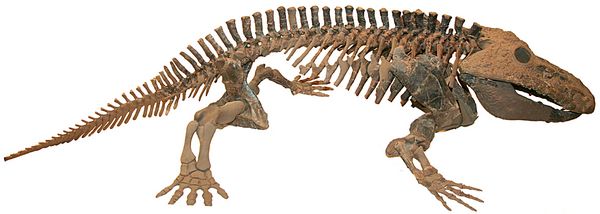Athena Review Image Archive ™
Eryops megacephalus skeleton

Skeleton of Eryops megacephalus (AMNH; photo: Athena Review).
Eryops megacephalus
was a large, Early Permian amphibian in a group called
Temnospondyls, ancestral to, and contemporary with, large
reptiles from the Early Permian. It dates to 295-280 mya.
The name Eryops megacephalus means "large-headed with extended face," derived from eryei- "drawn out;" -ops "face;" mega- "large;" -cephalus "head." It was discovered in 1877 by Cope in the Admiral Formation in Archer County, Texas, in the Permian Basin. E. megacephalus belongs to the class Amphibia, the order Temnospondyl, and the family Eryopidae. The nearly complete skull and skeleton in this image, now in the American Museum of Natural History (AMNH cat.4637) was discovered by E.C. Case in 1906.
Eryops was one of the largest land animals of its time, with a body length of 1.5-2.0 meters (5–6 ft) and a weight of about 90 kilograms (200 lb). The shoulder girdle was disconnected from the skull, which resulting in improved walking over the primitive amphibian condition. Sturdy limbs and a strong spine supported the body while out of water, another developed set of traits which approached the land-based reptilian condition.
The broad, flat skull of Eryops, 60 cm long, is proportionately large, resembling that of a salamander. Eryops’ eye sockets were large and directed upward like those of crocodiles. It had a large mouth with many sharp, conical teeth in strong jaws. The dentition was of labyrinthidont type ("maze-toothed"), with enamel in a complex folded pattern. The fang-like palatal teeth, combined with its wide-opening jaws, suggest Eryops practiced crocodile-like feeding.
References:
.Copyright © 1996-2020 Rust Family Foundation (All Rights Reserved).